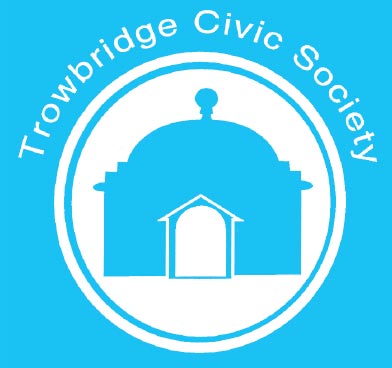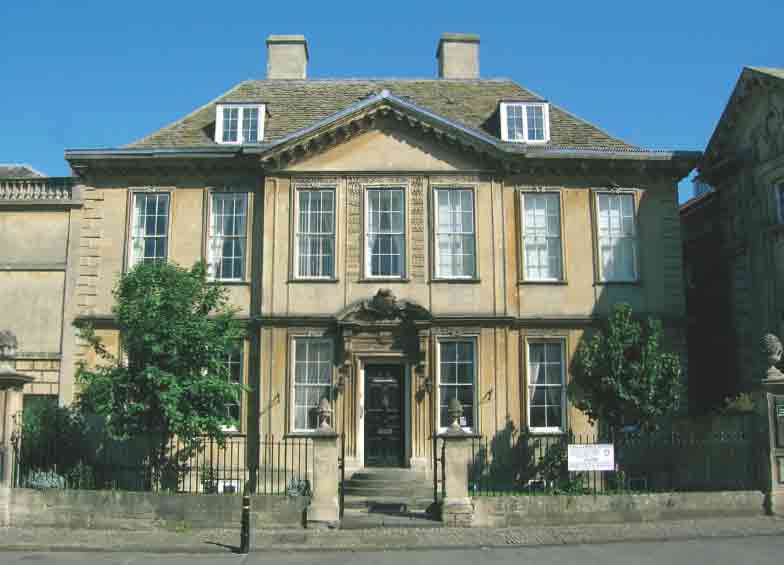| ||||||||||||||||||||||||||
Contents
Click on the item to go to the article. |
Editorial Comment
Our inspirational evening as guests of the Midsomer Norton Society (Aims: to research and appreciate our history and to influence the
present and future development of our town) reminded us how much we can learn from one another. It might be worthwhile forging more formal links with like–minded groups in the area – reciprocal membership, shared meetings/outings and exchange of publications come to mind. The deadline for copy for the autumn newsletter is Saturday 12 September, letters and articles are most welcome. |
Forthcoming Events
| 2009 | ||
| Tuesday 14th July 19:15 |
Guided Heritage walk around Devizes led by John Girvan | Meet at Market Cross in Devizes Market Place – cost £5 per head. |
| Saturday 15th August 10:30 – 12:00 noon |
Bring and Buy (Cake Stall, Bric–a–brac etc.) Proceeds to be shared with the Hope Centre. |
Hope Centre, Southwick Country Park |
| Wednesday 19th August | Coach trip to Castle Coch and Cardiff Castle. | Click HERE for full details |
| Saturday 12th September 10:00 – 16:00 |
Heritage Open Day (Click here for local sites) | More details nearer the time |
| Tuesday 20th October 19:30 |
PUBLIC LECTURE – Talk on the origin of Wiltshire Villages by Ken Rogers | Manvers Hall, United Church, Church Street, Trowbridge. |
From the Chairman
Now that we have become a unitary authority there have naturally been changes in organisation within the new Wiltshire Council. The area in which we as a society have most interest is of course with planning.
I was very interested to read in the Development Control Scheme of Delegation that one of the main changes is that parishes cannot bring an item to committee by simply objecting to it, as had previously been the case. Now, the local member has to make a written request setting out the material planning consideration(s) to warrant an application going before committee. I was particularly concerned to see that listed building consents to alter/extend a property and conservation area consents will not be eligible for call-in and will be dealt with under delegated powers by the planning officers alone. This may or may not be a good thing, we shall have to wait and see. The modern doors on two of the houses in St George's Terrace which was once complete, are the result of planning officer decision alone so this rule does not inspire confidence in the new system.
Despite the downturn it is good to see that work is beginning on the former Ushers bottling
site for the Sainsbury's supermarket and that work is continuing again on the development in
Duke Street. We can only hope that Wiltshire College will be able to secure the funding for
their new building on the Bowyers site. In all these things it seems that the people of
Trowbridge must be very, very patient.
Back to Contents
Planning Matters
The credit crunch means that there have been fewer applications for me to look at. Kings Farm, North Bradley, still features. The owner wishes to construct entry gates, piers and a wall with a tarmac apron. It is nice to see this recently endangered listed building nearing the end of its conservation and redevelopment. Rutland House having been refused a previous application as overdevelopment, has put in a revised plan, addressing the issues raised by the planners. The Stallards Inn has applied for listed building consent for rewiring and repairs to a chimney stack. Another listed building, 60 Castle Street (2 along from Sylvester and Mackett), has a large family residence on the upper floors. The area is not suited to families so they have been allowed to split it into two smaller units.
Hope Nature Centre has approval to extend its kitchen and indoor seating area. Now they have to raise the necessary funds! Wiltshire College; Trowbridge Campus’s plans for the former Bowyers site are with the planners, but due to gross over commitment by the Government department of the available funds for such developments countrywide, the future is uncertain at present. Mr Shanley’s recently refurbished shop in Church Street is still empty as potential occupants say it is too big for their purpose. He has submitted plans to turn the rear into a 1 bed groundfloor flat and divide the retail area into two halves to meet the market need.
7 Market Street has been taken over by a building society who wish to alter the windows and
door and put its name on the fascia and hanging sign. They clearly state that our Blue Plaque
commemorating the Victoria Institute will not be touched. In Court Street the former Tremans
factory can be demolished and 20 residential units can be built on the former site of Islington
Motors on Bradford Road.
Back to Contents
| An Apology | JA |
| In the last (Spring) edition in trying to make it clear that the Tabernacle buildings referred to by Jim Denning, in his article on the Almshouses, are on the site now known as the United Church I wrongly called it the United Reform Church. I hope Jim has forgiven me for my slack editing and apologise to him, to you and especially to all members of the United Church. | |
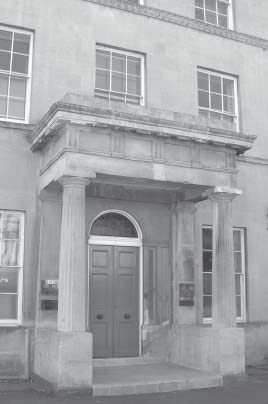 Classical Architecture in Trowbridge
Classical Architecture in Trowbridge
Following James Elliot's talk at the AGM I decided to have a look at what evidence there is of classical architecture in Trowbridge. You don't have to go far to find it because the facades of all of the grand mill owner's houses in the town centre together with many of the lesser houses are classical in detail or have elements of classical detail.
The Orders of classical architecture can be confusing. The first three, Doric, Ionic and Corinthian are Greek and the remaining two, Tuscan and Composite are Roman. All of these can be seen in the town (except the Composite order). The confusion arises with the Doric/Tuscan Order. Pevsner actually describes three forms: Greek Doric, Roman Doric and Tuscan Doric. Greek Doric columns have a capital and no base, Roman Doric has capital with base and both of these have ornamental entablatures. Tuscan Doric has capital and base but a plain entablature. Where I have described an order as Tuscan/Doric it is because Pevsner and the Department of the Environment List don’t agree on terminology. Where there is only one name, they agree. The word ‘order’ refers not only to the column but also the entablature which is the continuous band of horizontal stonework carried by the columns and is divided into three sections. A projecting section at the top, the Cornice, next a horizontal band called the Frieze which may be decorated or left plain and between the frieze and the column capitals, the Architrave which may consist of one or more horizontal bands. Above the Entablature is the pediment and most of its variations (broken, open, segmental and scrolled) can be seen on buildings in the town.
Rodney House porch is supported on fluted Greek Doric columns set straight onto their plinths and is the only example of Greek Doric in the town as far as I am aware. There is a band, or frieze of finely carved guilloche ornament (interlaced bands) combined with patera (round ornaments) between the first and second floors. Next door the porch of Polebarn House is supported on Ionic columns while above is a fine Venetian window, although there is nothing classical about the Gothic glazing bars!
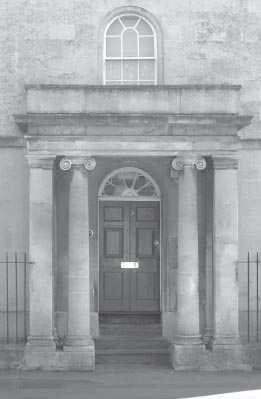
More Ionic detail can be seen on the facade of Bellefield House in Hilperton Road, where enormous pilasters stretch over the first and second floors. On the ground floor the Venetian windows, according to Pevsner, are “the over-arched Adam variety”, there are four of them and they are the only examples of this type in the town. In The Halve number 13 has Ionic columns supporting its porch while there are Tuscan/Doric columns flanking the Venetian doorway at number 5. Most of the door cases on the houses in The Halve have open pediments.
The HSBC Bank's doorway is flanked by Tuscan/Doric columns while the window above is flanked by Corinthian columns with a segmental pediment. The side is similar except that there are pilasters and not columns. Pevsner describes this building as, “amazingly stately”, while the Department of the Environment says, “an extremely imposing palazzo fronting to the south west.” More Tuscan columns can be seen on the NatWest Bank, and the splendid Lloyds Bank building next door which Pevsner describes as, ‘so grand as
to call to mind Genoa”, also has a doorway with Tuscan/Doric columns. Here, the first floor windows have alternating segmental and plain pediments. More classical detail is to be seen on the houses in The Parade which, according to Pevsner, is “the best group of ashlar-faced houses, really a stretch of palaces, and – as one can see better from the W than the E – at the same time a picturesquely, not monumentally composed group.” 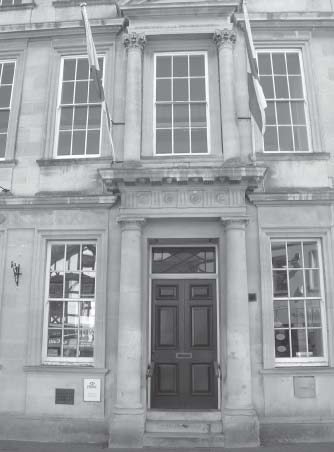 At the top of The Parade No 68, now housing The Vine Project, is another example of Corinthian over Tuscan/Doric like the HSBC Bank. Parade House, next door, has a good example of a scrolled pediment over the door, and the two houses below, numbers 71 & 72, both have Tuscan/Doric porches. The doorway on Barclays Bank, opposite has a segmental arch supported on Tuscan/Doric columns. The only variety of pediment I haven't yet spotted is a broken pediment (imagine a shallow triangle with a gap at the top).
At the top of The Parade No 68, now housing The Vine Project, is another example of Corinthian over Tuscan/Doric like the HSBC Bank. Parade House, next door, has a good example of a scrolled pediment over the door, and the two houses below, numbers 71 & 72, both have Tuscan/Doric porches. The doorway on Barclays Bank, opposite has a segmental arch supported on Tuscan/Doric columns. The only variety of pediment I haven't yet spotted is a broken pediment (imagine a shallow triangle with a gap at the top).
In The Conigre, Westcroft House doorway has Tuscan columns and pediment with a Venetian window above, and above this is a three bay pediment. An oddity is Lovemead House in Roundstone Street. Here the door surround has Doric pilasters and the central window above has a similar surround with a pediment, but the capitals remain unfinished. Rather amusingly Pevsner says, “The detail is not carefully done.” I remember Michael Lansdowne saying that the builders must have run out of money. The blocks above the pilasters are not really deep enough for Corinthian capitals so the original intention must have been either Doric or Ionic but we will never know. The doorway, plinth and quoins of St. James's Chambers in Union Street are good examples of vermiculated rustication.
There is a huge amount of classical detail in the town, far more that I have room for in this article, but I hope that James Elliot's talk will inspire you to go and have a look for yourselves.
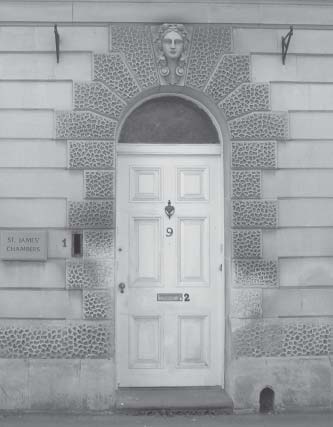
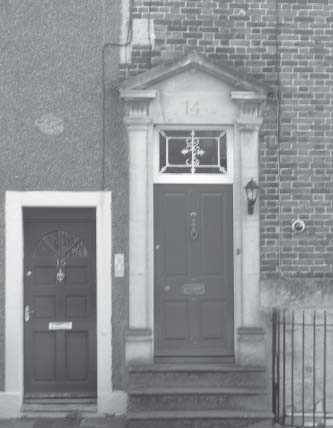
Working in the Mills – the reminiscenses of Miss Vera Cole
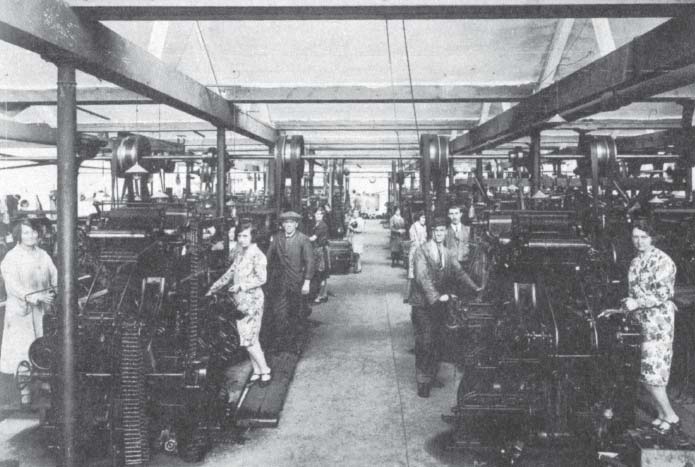
Vera was born in Trowbridge and attended St Thomas’s Infant School, Parochial Junior School and
Adcroft Girls School. When she left school in 1938 she was told that there were jobs as ‘twisters on’ in Palmer Mackays factory. The forewoman Mrs Rose sent a message to tell her to ‘come on down’ – and she started work at once. There were no interviews, in fact there was so much work available in Trowbridge that you could leave a job at lunchtime and have another by 2 o'clock! Somewhat different today. She had to have a long sleeved twill overall to wear at work which she bought in Taylors of Church Walk and when it was hot in the workshop she could roll the sleeves up. The hours were 7.45am – 5.45pm with an hour for lunch and Saturday mornings 8am - 12, holidays were Christmas day and Boxing day, Good Friday and Easter Monday, Whit Monday and the first week in August, a total of 2 weeks and her pay was 7/6 a week (i.e. 37p). Tea was provided mid mornings and afternoons, each person supplied their own cup which they filled from an urn on a trestle table, the piece workers returned immediately to work – they could not afford for the loom to stop.
Twisting on involved twisting bunches of yarn from the harness to the beam. Two girls sat together in the loom and when they had finished the beam was lifted into position for the loom tuners to set up. Occasionally, in the summer, whilst waiting for a loom, they would nip out to the Park Cafe to buy ice creams. In the winter the factory was heated by steam and quite often there was no heat and no hot water, especially on a Monday morning when they would be sent home and told to return after lunch when it may have warmed up. Often they worked in their coats to keep warm. Mrs Rose would sometimes send out the twisters–on to do her shopping and consequently they had no time to do their own (especially during the war).
Vera was called for war work in the Spitfire factory in Hilperton Road. She worked a 12 hour shift from 8am – 8pm, filing metal and assembling parts. This was piece work with a bonus payable if she had exceeded targets, one week she was told she would have a shock and opened her pay packet to find she had earned £5!
In September 1943 Queen Mary visited Palmer Mackays and chose a pattern woven by Jean Mizen, this was presented to the Queen and a sample is now in Trowbridge Museum. After the war Vera returned to Palmer Mackays and was asked to train as a weaver, and this she did for the next 17 years. It was very noisy work and Vera became an excellent lip–reader – a skill she retains (and very useful in a crowded café). As a piece work weaver she was paid per cloth, if the yarn was poor and kept breaking it could be a very slow job and the pay would be poor. If the loom broke down then the weaver was not paid whilst it was being fixed. However after about 9 years she was asked by a director, Mr Weddel, if she would like to become a pattern weaver, weaving samples for sales purposes. One of the other weavers warned her against it saying “It's a difficult job and if you take it you’ll be old before you’re young”! Vera was not deterred and became a pattern weaver for the rest of her time at Mackays - a further 9 years. In 1947 the workforce voted on a change of hours to work from 7.30am – 6.00pm Monday to Friday – it was wonderful to have Saturday mornings free. There were about 30 weavers and only 3 pattern weavers. Pattern weaving was paid on a standard weekly pay which cut out the uncertainty of how much money one would be taking home.
Once a cloth had been woven the weavers had to watch as it was inspected before being sent to the menders. The menders were nicknamed ‘The Ladies of the Factory’ because the mending shop was light and airy, they sat down all day and had their own toilet! The toilet facilities for the weavers were so bad most tried to ‘hang on’ until they arrived home. As time went on conditions gradually improved, better heating was installed, more cleaners employed and the unions brought in shorter working hours. It was not all hard graft as there were outings run by Stan Kemp. She remembers one outing that stopped at a pub 10 miles from Trowbridge and didn’t arrive at Weymouth until 5pm!
Palmer Mackays closed in 1963 and the workforce scattered. Many went to Tuckers in Frome, some to Lavertons in Westbury and some to Bowyers. Vera went to Tuckers. A coach picked up the workers from Trowbridge, she was picked up in Castle Street. She enjoyed working at Tuckers and was told there was plenty of work for years to come – however in 2 years that too closed. Redundancy was paid and included time worked at Palmer Mackays – the rate being £2 for each year worked, one man had worked for 52 years and was paid £100. She then joined Clarks this time as a cone winder as there were no weaving jobs available. This was a rather monotonous task winding the yarn on the cones for the quill winders and warpers. When Clarks merged with Salters, Vera moved there and stayed until she was 58 when it closed, still cone–winding. Here the pay improved with a minimum earnings level being introduced which she almost always attained. However ‘the Ladies of the factory’ were not so happy as they were housed on the ground floor in a windowless workshop (“like the black hole of Calcutta”); the rumour was that the management thought they may spend too much time looking out of the windows!
Vera recalls life in the mills as not easy, but she says she was ‘happy enough’. She made good friends
and a Saturday night could find her at the Regal or Gaumont. It was fascinating listening to her
memories. Some of the technical details of the work sounded so complicated I couldn't comprehend it
so we went to the museum where she cheerfully explained the jobs she did. I am grateful to Vera for
enlightening me on what it was really like and I am full of admiration for all those vast numbers of
Trowbridge people who worked so hard to earn their living in the mills.
Back to Contents
BOOK REVIEW – The Bowyers site in Trowbridge |
| In his detailed and illustrated local history study, Ken Rogers has traced the evolution of the area from the 17th century to the present revealing a variety of industries and buildings which today seems scarcely credible. The history of the site falls into two chronological parts, before and after the 1830s. The earliest buildings largely reflect the woollen industry and the necessary access to water. One exception saw the siting of an “unholy” alliance of a brewery and a Methodist chapel, both founded in 1789, although the latter fronted the main road. By the mid 1830s most of the existing site had passed into the hands of the woollen manufacturers. The chapel had become a wool warehouse and Samuel Salter had bought and subsequently sold the dyehouse and part of the brewery. The site as we know it began to take shape in the 1850s when Abraham Bowyer had a piggery and a slaughterhouse built on the land to the west of the Innox footpath which was almost immediately extended to include a bacon factory. Around the same time a cloth factory was built on the former brewery site and passed eventually into the ownership of Kemp and Hewitt until its closure in 1954. In 1918 Kemp and Hewitt extended their factory on land between Mill Lane and the Biss. It is likely that both were acquired by Bowyers to accommodate their meat processing business. Mr Rogers has mapped the principal sites, however Mill Lane,with a farrier, a foundry, the Innox Oil Company and numerous other enterprises remains the most varied. The study reflects the comprehensive and changing history of the site and is particularly relevant at this time when its future hangs in the balance. |
| John Allford |
| This publication is available, price £4, from the museum shop. |
Back to Contents
The Newtown Schools
At the beginning of the 19th century Trowbridge being a strong non–conformist area, there was pressure for a secular school at the Newtown end of the town. Initially Wesley Road Sunday school was used but an appeal was launched for a new British school. The site was donated by Sir Roger Brown and other major funding came from wealthy non–conformists including Mr W J Mann, the Haden family, John Stancomb and the Usher family. The architect was Thomas Ball Silcock, also a non–conformist. The Headmaster commented in the log book “the plans for our new schools, together with the timetable, are to be shown at the forthcoming Paris Exhibition as typical of a Modern British school”. The plans won an award. On 5th May 1900 a procession of children, together with the committee and friends marched from the Town Hall to the site of the new building with about a dozen decorated wagons hired to carry the infants. The foundation stone was laid by Sir Roger Brown. Jacob Long and Sons of Bath were the builders. By the time the school was opened on 27 March 1901 there were 200 children being taught in the Wesley Road premises. The building cost, excluding the value of the site, including heating and ventilation, architect's fees, bank interest, furnishings and fees, was £6400. The Wiltshire Times reported “The building, which is of the central hall type of elementary school, is a handsome and imposing structure which will add considerably to the attractiveness and dignity of the neighbourhood, solidly constructed of brick with Bath stone facings, it may safely be predicted that it will last for many years, and play an important part in teaching the young of Trowbridge, for many generations”. An early HMI called it “the most beautiful and up–to–date school in the West of England”. Nikolaus Pevsner wrote “Extremely pretty, brick and stone, symmetrical, in a domestic neo– Baroque”. Despite the new surroundings illness was often a major problem and soon after the opening the infant section was closed by a measles epidemic, deaths from diphtheria occurred in 1909 and in November 1918 influenza closed the school for a while. In 1909 the school was transferred to Wiltshire County Council and renamed as Newtown Council Schools (“school” and “schools” are used rather loosely, the latter term generally indicating that the building contained separate boys and girls sections). It was an all age school, providing education from entry until the leaving age of 14. By 1919 the number of children was such that the hall was used for two classes with a screen between. By the mid 1920s three classes were taught in the undivided hall. Each of the infant classes had close to 50 pupils. Fortunately in June 1928 Trinity Infants School was opened on the adjacent site and relieved a lot of the pressure, and classes were no longer taught in the hall.
At this point it is useful to consider the earlier Trinity schools which served the same area of the town. The
building (still there) next to Trinity Church was opened as a girls school in 1836 but by 1857 had become a mixed
school. In 1873 Trinity Boys National School was erected on the Park Street site and by 1877 had a roll of over
200. In 1892 a mixed Infant section was opened on the same site, the boys moving up to the Trinity Boys School at
the age of 7, and the girls going to the Girls School in the Stallard Street building. The opening of the Newtown
Schools led to a decline in attendance and in 1923 the Trinity Girls School was closed (the church schools in
Trowbridge were amalgamated). 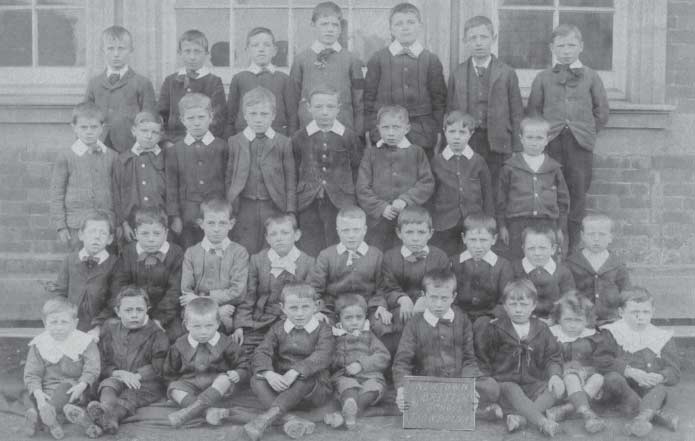
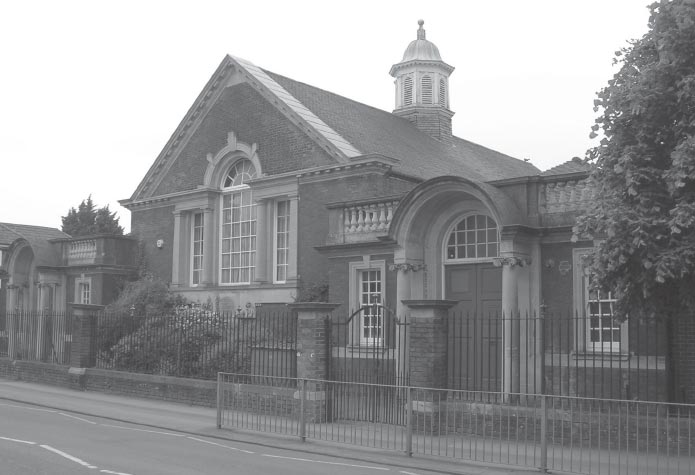
In 1926 it was decided to amalgamate the Infants from Newtown Schools and Holy Trinity (Park Street site) and the new five classroom building, for 200 pupils, was built by Holdaways of
Westbury. As has already been said it opened in 1928, with Miss Blanchard appointed as Head teacher.
In July 1929 William Hodgson, Head of Newtown since its inauguration in 1898, retired and was succeeded by
Ernest Hughes from Westbury. He was soon faced with a major crisis following the death of a pupil from
diphtheria, the school was closed for three days to be disinfected, and the threat of the disease was to linger for
years. As a result of the Hadow report in 1931 Wiltshire reorganised its schools into Primary and 11+ Senior
schools. Newtown was designated as the Senior Mixed School for that end of the town. The village schools now
lost all their pupils at age 11, either to the nearest Senior school or a Grammar school. The Park Street school
became Trinity Junior Mixed Council School with Mr William Dyke–Meek continuing as Head – he had been
appointed as such in 1926. By 1937 the school was overcrowded and two of the six classes were taught in the
same room. During the summer holiday in 1938 electricity was installed in Newtown School.
At the Infants and Junior schools, as the Second World War loomed, the children were fitted with gas masks. The Infant school was sandbagged and in July 1940 two shelters were erected, each to hold 50 children, Air Raid practices were held regularly. The evacuation of children from London meant major re–organisation in the Senior School. In May 1939 Newtown became Newtown Senior Boys Council School. The girls went to Trinity Church Hall and Bethesda Sunday School. Three weeks later the Hammersmith School of Building moved to Trowbridge and by June there were 243 local boys and 66 evacuees in the school. In 1940 Newtown became Newtown Junior Mixed Council School and new secondary schools for 400 girls and 400 boys were built on the Galley Farm site (see previous Newsletter) on Frome Road. These took children from the age of 11 from the whole of Trowbridge and its surrounding villages and Ernest Hughes, the Head of Newtown Senior School, became the new Head of Nelson Haden Boys School. Miss V Ruth Pickett, Head of Adcroft Senior Girls School, became the Head of the new girls secondary school.
A major change that was to outlive the War began in November 1942. Hot dinners were supplied for the first time from a centre in Holt so that children with mothers on war work could receive some warm food. 56 meals were provided, 18 of these for infants. In about 1947 Miss Edna Hall was appointed to take Miss Blanchard's place on her retirement as Head of Trinity Infants. In 1948 because of increasing numbers, pupils leaving the Infant School entered the re–opened Park Street building for their first year at Newtown Junior School. (This cohort included one of your editors and he was taught there by Bessie Rodway). Meanwhile Mr Dyke–Meek had become Head at Newtown Junior and in 1949 he was succeeded by Mr Ralph Warburton. He introduced the first school uniform (maroon blazers for the boys and maroon cardigans for the girls), ran two football teams from 1950 and organised cricket coaching. The Flower Show field and Nelson Haden pitches were used for home soccer matches. 1954 saw another name change with “Council” being replaced by “County” to read Trowbridge Newtown County Junior School. At that time there were 484 pupils. By September 1957 the roll peaked at 509 but from 1960 other primary schools were established in the town, taking some of the pressure from Newtown. These new schools are Studley Green, the Grove, Holbrook, Walwayne Court, Longmeadow, Paxcroft and Paxcroft Mead. Together with St. John's and Bellefield there are now ten schools in the town, spread like spokes around a wheel. At the hub lies the oldest primary school still in its original building – Newtown. In May 1964 John Hicks was appointed Head teacher. At Easter 1967 a swimming pool was built in what had been the gardening area and in 1968 two mobile classrooms were set up on the playground, the allotments were converted to a play area and the cloakrooms were extended. In April 1982 John Hicks retired and Tim Hill was appointed Head. In July 1992 Park Street annexe finally closed as part of the school (but reopened as Trinity Education Centre) and it was decided to amalgamate Newtown Junior and Trinity Infant Schools. In 1993 the new school was named Newtown County Primary School with Richard Craft as Head and Ann Carter, the previous deputy Head of the Infants, made Deputy. A physical link between the buildings was begun with offices and a library. In September 1999 yet another name change produced Newtown Community Primary school.
On 23 June 2000 the school's centenary was celebrated. A drama day in Victorian costume was held and the extensive museum of the history of the school was opened to former pupils and staff. The 28th saw the re-enactment of the procession from the town to the school by pupils, staff and parents in Victorian costume, headed by the Queen's representative in Wiltshire, Sir Maurice Johnston, the Mayor of Trowbridge, Cllr Angela Milroy and Trevor Heeks, the Trowbridge Town crier, behind a banner designed and created by the children and parents. Former pupil, Janet Anderson MP, Minister for Tourism, Films and Broadcasting, also attended.
In 2000 Richard Craft retired and Sue Ivermee was appointed as the new Head teacher. Since 2004 she has been
succeeded by Mrs Marion Bartlett and Ms Kate Strugnall (present Acting Head) with Mr Tom Hill due to take up
the Headship this coming September. Newtown School has fulfilled the vision of those individuals who generously
supported the idea of a new school in Newtown in the late 1890s – “to play an important part in the teaching of
the young of Trowbridge for many generations”. This role will continue well into the new millennium.
Back to Contents
RECENT MEETINGS |
Annual General Meeting 17th March 2009
Over forty members attended with apologies received from twelve members who were unable to be present. During the brief business meeting the Chairman, Glyn Bridges, the Treasurer, Kay Austin and Secretary, Celia Russell were all re–elected as were the existing Executive Committee members, Peter Bull, Kevin Hartley, Jonathan Hawkes, Margaret Howard and Diana Ingram with the welcome addition of new Executive Committee member, Diana King. Mr Patrick Andrews was appointed as Auditor. The Treasurer presented the accounts and said the Newsletter cost for the year was £160. Mr. Roger Newman said the Newsletter was superb value, a sentiment which seemed to be echoed by all present. With the business meeting concluded the Chairman introduced the speaker, Mr. James Elliott.
JAMES ELLIOT – Architect 17th March 2009
James, who is a longstanding member of the Society, entertained the post–AGM audience of nearly 50, describing his training and practice, 17 years of which was spent as the City of Bath Listed Buildings Architect. He showed a keen interest in historic buildings at school and at UCL Bartlett's School of Architecture was soon immersed in the Greek classical form. He showed us his first term major project – a beautifully detailed and exquisitely shaded representation of the Doric facade of the Parthenon – and many other drawings. He referred to Vitruvius's 10 volume book of architecture of the time and “The Builder's Jewel” – so detailed that it's no surprise that local builders never produced bad Georgian buildings.
His work in Bath coincided with an age of enlightenment with about 5000 grand houses, most of them listed, for him to look after. (Unfortunately post–war about 2000 smaller Georgian houses were demolished). During this period James was allowed to continue his private practice, provided it dealt with buildings outside the city limits! One of his greatest pleasures was to see Bath chosen as a UNESCO World Heritage Site. The future for listed buildings is by no means secure in view of the present economic crisis and he is unhappy that most local authorities no longer require full professional architectural training for Conservation Officers. In many ways our built heritage is as vulnerable as it was when a young James was cycling around a London borough to recognise areas to be conserved and buildings to be listed. (Hence the need for vigilance by civic, conservation and preservation societies and trusts etc.)
After James's talk there were questions and answers, delicious cakes and coffee, a raffle (thanks respectively to Ruth Bridges and Peter Bull) and much lively chatter to end the evening.
BERKLEY AND RODDEN CHURCHES 20th April 2009
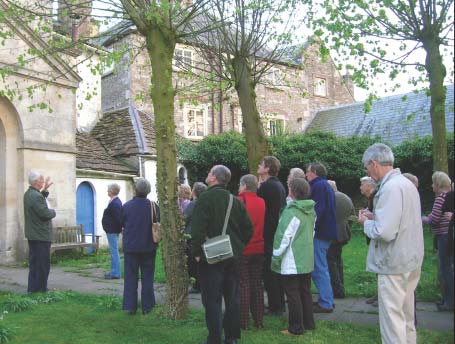 On a beautiful spring evening 19 members of the Civic Society, led by Chairman Glyn Bridges, visited these
two small interesting churches. St Mary's is attached to Berkley House, which allowed the occupants of the latter to have their own
church entrance. Both buildings date from 1751. Close–by is the village school. Before we entered the church, accompanied by a background
chorus of birdsong from chiff–chaffs and thrushes, Glyn outlined the history of the building. Standing there, one was struck
by the distinctive church tower and large verdant churchyard containing yews, pollarded limes, and many wild flowers including bush vetch
and wood anemone. The last two are indicators of ancient woodland, which seemed appropriate, as the name Berkley is derived from the
Old English for a clearing in a birch wood. The church, recently repainted, is a gem of a Georgian structure, described by Pevsner as the best of its type in Somerset. Particularly notable is the eight panelled lantern tower decorated with delicate plasterwork. Although Berkley could be described as a hamlet, the extent of the parish boundaries is revealed by the large number of names on the war memorial inside the church, indicating those who served as well as the fallen.
On a beautiful spring evening 19 members of the Civic Society, led by Chairman Glyn Bridges, visited these
two small interesting churches. St Mary's is attached to Berkley House, which allowed the occupants of the latter to have their own
church entrance. Both buildings date from 1751. Close–by is the village school. Before we entered the church, accompanied by a background
chorus of birdsong from chiff–chaffs and thrushes, Glyn outlined the history of the building. Standing there, one was struck
by the distinctive church tower and large verdant churchyard containing yews, pollarded limes, and many wild flowers including bush vetch
and wood anemone. The last two are indicators of ancient woodland, which seemed appropriate, as the name Berkley is derived from the
Old English for a clearing in a birch wood. The church, recently repainted, is a gem of a Georgian structure, described by Pevsner as the best of its type in Somerset. Particularly notable is the eight panelled lantern tower decorated with delicate plasterwork. Although Berkley could be described as a hamlet, the extent of the parish boundaries is revealed by the large number of names on the war memorial inside the church, indicating those who served as well as the fallen.
Nearer to Frome, our next church was approached through Rodden Farm. Strangely Rodden itself was a parish with a church and a manor house but without a real village. In an extremely pastoral setting, the church dating from 1640, 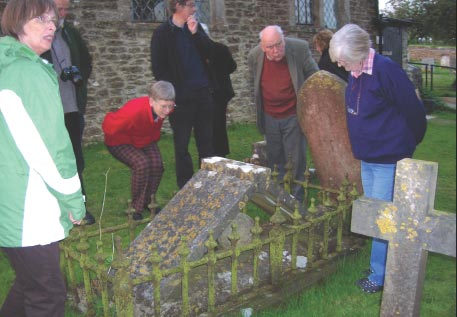 looks down on Rodden Brook, a tributary of the Frome. Along its length the brook historically had a corn and a cloth mill. Within the churchyard, one tomb particularly caught the eye. It was that of Major Robert Carmichael of the Highland Regiment and featured a suspended globe depicting how travelled a soldier he had been.
Although their tombs were not visible, several members of the A'Court Family are buried at the church. In the 17th century a John
A'Court of Rodden married a Miss Elizabeth Ashe of Heytesbury House and their son became the heir of that estate; a grandson in 1793 becoming a baronet. Finally, it is pleasing to report that this splendid little church has a strongly supportive congregation.
looks down on Rodden Brook, a tributary of the Frome. Along its length the brook historically had a corn and a cloth mill. Within the churchyard, one tomb particularly caught the eye. It was that of Major Robert Carmichael of the Highland Regiment and featured a suspended globe depicting how travelled a soldier he had been.
Although their tombs were not visible, several members of the A'Court Family are buried at the church. In the 17th century a John
A'Court of Rodden married a Miss Elizabeth Ashe of Heytesbury House and their son became the heir of that estate; a grandson in 1793 becoming a baronet. Finally, it is pleasing to report that this splendid little church has a strongly supportive congregation.
ROSE AND CROWNSince the last newsletter I have heard from Michael Beveridge of Enterprise Inns that the pub has closed because of short/mid-term difficulties. So far my response, which included the offer of some terracotta masonry paint, has not been answered. JA |
CORPORATE MEMBER – Coleman’s Family Dental Practice, Timbrell Street |
Some Trowbridge Milestones
Trowbridge is not rich in milestones. All I can trace are slabs of stone most with cast-iron plates. The plates replaced the inscribed stone but there is no evidence of any earlier type in the town. The Andrews and Dury map of 1773 shows the main road from Trowbridge to Salisbury running along what is now Green Lane and marks three milestones, 24,25 and 26 miles to Salisbury. Some milestones have had to be removed due to changes in road layout and the plates are prime targets for souvenir hunters. Some of the plates are replacements but following the original design.
99 miles to London: this one originally stood by the wall of Lovemead garden, but has been moved and now stands in solitary state on the grass the other side of the Halve.
99 London Trowbridge 2 Westbury 3: It stands on the east side of Westbury Road, North Bradley, opposite the junction of Church Lane and is nearly obscured by the hedge behind and undergrowth. Although it is not on a road to London it may have been copied from the Trowbridge stone above.
1864 Trowbridge1 Devizes 9 Melksham 4: this stands on the east side of Hilperton Road opposite Fieldways. It originally was nearer Hilperton, in the vicinity of the new roundabout, and was moved by the Civic Society to its present position to preserve it. The plate is, I believe, a replica.
To Bath 10: this stands on the south-west side of Trowbridge in Bradford Road, just past the Westwood Road junction. The plate and lettering look modern.
To Bath 9: this is actually in Bradford, a hundred yards or so beyond the canal bridge. This is inscribed stone, although the discoloration suggests there may have been a plate at one time. The lettering looks distinctly old, C18 or early C19. This and the previous could be two of the same series.
A plain unmarked stone stands on the verge approaching Southwick from Trowbridge.
Members of the Civic Society may be able to suggest corrections, or additions to this article and, if so, I should be
pleased to hear of them.

Back to Contents
Heritage Open Days in Trowbridge
| Date | Opening Time(s) |
Town | Property |
| Thu 10th Sept | 1800–1930 | Trowbridge | Trowbridge Museum, Dobcross loom demonstrations by Ivan Clarke. |
| Fri 11th Sept | 1930–2100 | Trowbridge | Trowbridge Reference Library, Lecture by Ken Rogers – Looking back at the Somerset and Wiltshire Woollen Industry. Tickets from Trowbridge Museum – Booking essential. |
| Sat 12th Sept | 1000–1200 | Trowbridge | Weaving Walk, Led by Ken Rogers – Meet at TIC, St Stephen's Place |
| Sat 12th Sept | 1400–1600 | Trowbridge | Trowbridge Museum, Talk by Roy Berrett – “When Time Ran Out, The fnal years of the woollen industry.” |
| Sat 12th Sept | 1000–1600 | Trowbridge | The Blind House, Wicker Hill, BA14 8JU. From town centre, walk down Fore Street to town bridge. Use town centre car parks. |
| Sat 12th Sept | 1000–1600 | Trowbridge | St Thomas's Church, St Thomas Road |
| Sat 12th Sept | 1000–1600 | Trowbridge | Holy Trinity Church, Stallard St - on the roundabout, close to Trowbridge Station. Small car park and on street parking nearby. |
| Sat 12th Sept | 1000–1600 | Trowbridge | Trowbridge Cricket Club Pavilion, Lower Court, Trowbridge, BA14 8PX – Guided Tours. |
| Sat 12th Sept | 1000–1600 | Trowbridge | Zion Baptist Church, Union Street, Trowbridge BA14 8RU – Historical Display. At 14:00, there will be an illustrated talk by Zion Church historian, Andrew Jones. |
| Sun 13th Sept | 1400–1600 | Trowbridge | St James Bell Tower, Church Walk, Trowbridge. |
Back to Contents
| Welcome to the following new members: | Mr G Baldwin; Mrs M Cole; Mrs V Fritz; Mr A Hall; Mrs M Smith |
©Trowbridge Civic Society 2009
